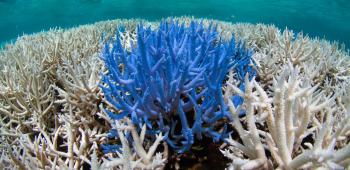Biodiversity and ecosystems
Description
The Sustainable Development Goal 15 of the 2030 Agenda for Sustainable Development is devoted to “protect, restore and promote sustainable use of terrestrial ecosystems, sustainably manage forests, combat desertification, and halt and reverse land degradation and halt biodiversity loss”.
At the Rio+20 Conference, Member States reaffirmed, through paragraphs 197- 204 of the outcome document, the Future We Want, that “intrinsic value of biological diversity, as well as the ecological, genetic, social, economic, scientific, educational, cultural, recreational and aesthetic values of biological diversity and its critical role in maintaining ecosystems that provide essential services, which are critical foundations for sustainable development and human well-being”. Member States also recognized “the severity of global biodiversity loss and degradation of ecosystems” and stress the negative impact that this situation has on food security, nutrition, access to water, health of the rural poor and people worldwide”.
Furthermore, the Future We Want reiterated the importance of implementing the Strategic Plan for Biodiversity 2011-2020, and achieving the Aichi Biodiversity Targets adopted at the Tenth Conference of the Parties to the Convention.
Biodiversity was discussed by the Commission on Sustainable Development on several occasions, and was one of the themes of the 2012/2013 two-year cycle.
At the World Summit on Sustainable Development, held in Johannesburg 2002, biological diversity was addressed in Chapter IV, paragraph 44, of the outcome of the Summit, the Johannesburg Plan of Implementation. The Summit also endorsed the target to achieve, by 2010, a significant reduction of the rate of biodiversity loss at global, regional and national levels as a contribution to poverty alleviation and to the benefit of all life on earth, which had some months earlier been adopted by the sixth meeting of the CBD Conference of Parties (COP).
Conservation of biological diversity is the subject of Chapter 15 of Agenda 21 which was adopted at the United Nations Conference on Environment and Development, in 1992, in Rio de Janeiro. On the same occasion, the United Nations Convention on Biological Diversity (CBD), was opened for signature and remained open for signature until 4 June 1993. By that time, it had received 168 signatures. The Convention entered into force on 29 December 1993, 90 days after the 30th ratification. The first session of the Conference of the Parties was scheduled for 28 November – 9 December 1994 in the Bahamas.
For more information and documents on this topic, please visit this link.
Pagination
Pagination
Milestones
-
January 2015 SDG 15- BiodiversityAmong the multiple challenges to sustainable development enumerated in paragraph 14 of the 2030 Agenda for Sustainable Development, a particular attention is devoted to natural resources depletion and the adverse impacts of environmental degradation, including loss of biodiversity. Through paragraph 33, the 2030 Agenda for Sustainable Development focuses on the linkage between sustainable management of the planet’s natural resources and social and economic development and reaffirms the determination of Member States to protect biodiversity, ecosystems and wildlife. In the framework of the Sustainable Development Goals, SDG 15 aims to “protect, restore and promote sustainable use of terrestrial ecosystems, sustainably manage forests, combat desertification, and halt and reverse land degradation and halt biodiversity loss”. In particular, SDG target 15.5 reads “take urgent and significant action to reduce the degradation of natural habitats, halt the loss of biodiversity and, by 2020, protect and prevent the extinction of threatened species”.
-
January 2012 Future We Want (Para 197-204)Biodiversity is the subject of Paragraphs 197- 204 of Future We Want. In that context, Member States reaffirm the “intrinsic value of biological diversity, as well as the ecological, genetic, social, economic, scientific, educational, cultural, recreational and aesthetic values of biological diversity and its critical role in maintaining ecosystems that provide essential services, which are critical foundations for sustainable development and human well-being”. Member States also recognize “the severity of global biodiversity loss and degradation of ecosystems” and stress the negative impact that this situation has on food security, nutrition, access to water, health of the rural poor and people worldwide”. Future We Want also reiterates the commitment of Member States in the achievement of the three objectives enunciated in the Convention on Biological Diversity and reaffirms, through paragraph 198, the importance of implementing the Strategic Plan for Biodiversity 2011-2020, and achieving the Aichi Biodiversity Targets adopted at the Tenth Conference of the Parties to the Convention.
-
January 2011 UN Decade on BiodiversityWith the adoption of Resolution 65/161, the UN General Assembly declared the period 2011-2020 to be “the United Nations Decade on Biodiversity, with a view to contributing to the implementation of the Strategic Plan for Biodiversity for the period 2011-2020”. The Decade has been established in order to support the implementation of the Strategic Plan for Biodiversity and promote its overall vision of living in harmony with nature. It has aimed at mainstreaming biodiversity at different levels. Throughout the United Nations Decade on Biodiversity, governments have been encouraged to develop, implement and communicate the results of national strategies for implementation of the Strategic Plan for Biodiversity.
-
January 2011 CSD-19 (Chap.2)Biodiversity was discussed by the Commission on Sustainable Development on several occasions and was one of the themes of the 2012/2013 two-year cycle. CSD-19 was held in May 2011 to negotiate policy options related to the thematic cluster for the CSD 18-19 cycle: transport, chemicals, waste management, mining and the Ten-Year Framework of Programmes (10YFP) on Sustainable Consumption and Production (SCP) Patterns.
-
January 2010 International Year of BiodiversityThe United Nations declared 2010 as International Year of Biodiversity to highlight the crucial role that biodiversity has in the lives of each individual, raise awareness of the actions taken by people worldwide to fight against biodiversity loss and increase understanding of the vital role that biodiversity plays in sustaining life on Earth.
-
January 2002 JPOI (Chap. 4)In 2002, the World Summit on Sustainable Development, in Johannesburg, addresses biological diversity in Chapter 4, paragraph 44, of the Johannesburg Plan of Implementation. The Johannesburg Summit also endorses the target to achieve, by 2010, a significant reduction of the rate of biodiversity loss at global, regional and national levels as a contribution to poverty alleviation and to the benefit of all life on earth, which had some months earlier been adopted by the sixth meeting of the CBD Conference of Parties (COP).
-
January 2001 Millennium Ecosystem AssessmentThe Millennium Ecosystem Assessment (MA) was launched in 2000 with the aim of appraising the impact that ecosystem change have on human well-being and of identifying the scientific basis for action to ensure a better conservation and sustainable use of these systems.
-
January 1992 Agenda 21 (Chap.15)Chapter 15 is devoted to conservation of biological diversity and is intended "to improve the conservation of biological diversity and the sustainable use of biological resources, as well as to support the Convention on Biological Diversity".
-
January 1992 UN CBDThe Convention on Biological Diversity was inspired by the rising commitment of the International Community towards sustainable development. It represents a historical step forward in the conservation of biological diversity, the sustainable use of its components, as well as the fair and equitable sharing of benefits arising from the use of genetic resources.


